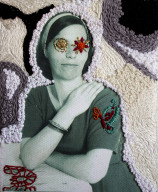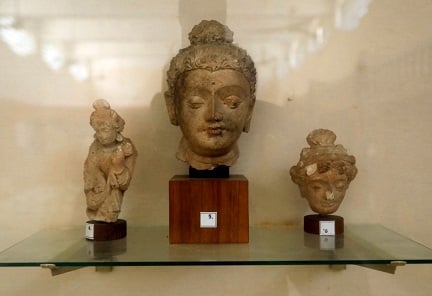
KARACHI: An incomplete building that was supposed to be a cultural complex has been standing for decades in between the Karachi Registry of the Supreme Court of Pakistan and the Arts Council of Pakistan. Not many passers-by would know that Aiwan-e-Riffat was once bestowed upon legendary couple Atiya and Fyzee Rahamin.
Intellectual, writer and the first woman of the Indian sub-continent to attend the University of Cambridge, Atiya Fyzee Rahamin is remembered today as a highly learned lady whose intellectual charm impressed men of letters like Shibli Nomani and Allama Iqbal. Her husband, Samuel Fyzee Rahamin, a man of Jewish lineage who later converted to Islam, was an equal genius in his own right. He was a painter of high calibre besides being a novelist and a playwright. A personal friend of Quaid-i-Azam, Fyzee was invited by the father of nation himself to shift to Karachi from India after Partition.
The couple has left behind a place that was bestowed upon them when they moved to Pakistan in Burnes Garden. The place was named Aiwan-i-Riffat after their previous residence in Mumbai that bore the same name.
Art gallery opens in Muzaffarabad
So much is unveiled when one visits Aiwan-i-Riffat and meets Syed Saif Abbas Hasani, senior director of the Karachi Metropolitan Corporation's (KMC) culture, sports and recreation department, and Bilquees Bano, the librarian at Aiwan-e-Riffat.
"She came from a royal household. The family was exceedingly learned and made sure that the girls got a proper education. The youngest among the three sisters, Atiya was an extremely talented woman," said Bano.
"In 1906, she was sent to England to study, but rushed back in a year's time because of her ill health. She had also made a trip to Europe before that with one of her sisters and in her letters home, she commented extensively on European life," Bano added.
‘Karachi Art Summit takes inspiration from Dhaka Art Summit’
She said the couple came to Pakistan in 1948 at the request of Quaid-i-Azam. Fyzee had been a friend and neighbour to the father of the nation when he lived at Malabar Hills in Mumbai. When they arrived in Karachi, a portion of Burnes Garden was gifted to them where they built their residence and an art gallery, named the Fyzee Rahamin Art Gallery, Bano said. However, after 1950 they were asked to vacate the place. According to the librarian, no documents are present that could reveal the reason for the couple's ousting from Aiwan-e-Riffat.
The story turns dismal after that, as the couple had to live in an impoverished state. "They lived at a local hotel and their friends abroad were asked to pay their hotel bill," said Hasani.
However, Atiya once again became the owner of Aiwan-e-Riffat when she won a court case over the possession of the property. Her husband had unfortunately passed away by then and she decided not to move back. Instead, she signed an agreement with the KMC, making it a trustee to Aiwan-e-Riffat with no authority to ever be able to sell the place, informed Hasani.
Art and literature - two sides of the same coin
It was former KMC director Saifur Rehman Grami's idea to convert the building into a cultural complex, according to Bano. "He envisioned a complete cultural complex at this place. The tea-pink structure erected here was also Grami's idea," she shared.
"In 1990, Farooq Sattar, who was then the mayor of Karachi, visited Lahore and paid a trip to Alhamra where he saw its art gallery and auditorium, which had the capacity of seating of 1,500 people. He decided to make a bigger and finer structure in Karachi, which would have a seating capacity of 1,800. For this, he chose Aiwan-i-Riffat and hired the National Engineering Services, Pakistan as a consultant for designing the auditorium," Hasani explained.
When the work began in 1990, the construction cost was estimated at Rs80 million, he said, however, with the regime change in 1992, the work stopped for indefinite period despite the fact that almost 50% construction had been completed at a cost of Rs20 million. It was in 2006 when the then mayor Mustafa Kamal paid attention to the abandoned project. He was informed that about Rs500 million would be required to complete the cultural centre but no progress was made thereafter, Hasani lamented. Today, the place bears a forlorn look.
44 artworks of Bin Qulander on display in Karachi
The current estimated cost for the completion of the project is Rs1 billion but it seems that the KMC and provincial government are least interested in its completion as work is still on hold.
Nonetheless, the place has survived and continues to be a trust property of KMC. However, the purpose for which it was handed over to the KMC was never served, which was hosting painting exhibitions, manuscripts, books, antiques and belongings of Fyzee and Atiya.
The project under Farooq Sattar had envisioned basement car parking, Fyzee Rahamin Art Gallery, a permanent picture gallery, office, contemporary painting exhibition hall and three conference rooms. The first floor was to comprise a seminar room, orchestra room and snack counter, whereas the second floor was supposed to house THE Khawaja Moinuddin Auditorium, which would comprise 1,800 individual seating arrangements, an orchestra pit and revolving stage.
This Pakistani artist's futuristic depiction will blow you away
The plan was never materialised and the place continues to be in limbo.





























































COMMENTS
Comments are moderated and generally will be posted if they are on-topic and not abusive.
For more information, please see our Comments FAQ